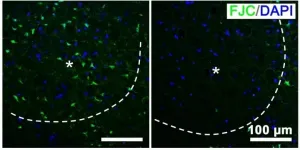An illuminating possibility for stroke treatment: Nano-photosynthesis
2021-05-19
(Press-News.org) Blocked blood vessels in the brains of stroke patients prevent oxygen-rich blood from getting to cells, causing severe damage. Plants and some microbes produce oxygen through photosynthesis. What if there was a way to make photosynthesis happen in the brains of patients? Now, researchers reporting in ACS' Nano Letters have done just that in cells and in mice, using blue-green algae and special nanoparticles, in a proof-of-concept demonstration.
Strokes result in the deaths of 5 million people worldwide every year, according to the World Health Organization. Millions more survive, but they often experience disabilities, such as difficulties with speech, swallowing or memory. The most common cause is a blood vessel blockage in the brain, and the best way to prevent permanent brain damage from this type of stroke is to dissolve or surgically remove the blockage as soon as possible. However, those options only work within a narrow time window after the stroke happens and can be risky. Blue-green algae, such as Synechococcus elongatus, have been studied previously to treat the lack of oxygen in heart tissue and tumors using photosynthesis. But the visible light needed to trigger the microbes can't penetrate the skull, and although near-infrared light can pass through, it is insufficient to directly power photosynthesis. "Up-conversion" nanoparticles, often used for imaging, can absorb near-infrared photons and emit visible light. So, Lin Wang, Zheng Wang, Guobin Wang and colleagues at Huazhong University of Science and Technology wanted to see if they could develop a new approach that could someday be used for stroke patients by combining these parts -- S. elongatus, nanoparticles and near-infrared light -- in a new "nano-photosynthetic" system.
The researchers paired S. elongatus with neodymium up-conversion nanoparticles that transform tissue-penetrating near-infrared light to a visible wavelength that the microbes can use to photosynthesize. In a cell study, they found that the nano-photosynthesis approach reduced the number of neurons that died after oxygen and glucose deprivation. They then injected the microbes and nanoparticles into mice with blocked cerebral arteries and exposed the mice to near-infrared light. The therapy reduced the number of dying neurons, improved the animals' motor function and even helped new blood vessels to start growing. Although this treatment is still in the animal testing stage, it has promise to advance someday toward human clinical trials, the researchers say.
INFORMATION:
The authors acknowledge funding from the National Key Basic Research Program of China, the National Natural Science Foundation of China, the Chinese Ministry of Education's Science and Technology Program, the Major Scientific and Technological Innovation Projects in Hubei Province, and the Joint Fund of Ministry of Education for Equipment Pre-research.
The paper's abstract will be available on May 19 at 8 a.m. Eastern time here: http://pubs.acs.org/doi/abs/10.1021/acs.nanolett.1c00719.
The American Chemical Society (ACS) is a nonprofit organization chartered by the U.S. Congress. ACS' mission is to advance the broader chemistry enterprise and its practitioners for the benefit of Earth and all its people. The Society is a global leader in promoting excellence in science education and providing access to chemistry-related information and research through its multiple research solutions, peer-reviewed journals, scientific conferences, eBooks and weekly news periodical Chemical & Engineering News. ACS journals are among the most cited, most trusted and most read within the scientific literature; however, ACS itself does not conduct chemical research. As a leader in scientific information solutions, its CAS division partners with global innovators to accelerate breakthroughs by curating, connecting and analyzing the world's scientific knowledge. ACS' main offices are in Washington, D.C., and Columbus, Ohio.
To automatically receive news releases from the American Chemical Society, contact newsroom@acs.org.
Follow us: Twitter | Facebook
[Attachments] See images for this press release:

ELSE PRESS RELEASES FROM THIS DATE:
2021-05-19
WASHINGTON, DC (May 19, 2021) - Human genetics and genomics contributed $265 billion to the U.S. economy in 2019 and has the potential to drive significant further growth given major new areas of application, according to a new report issued today by the American Society of Human Genetics (ASHG). The findings indicate that this research and industry sector has seen its annual impact on the U.S. economy grow five-fold in the last decade and outlined at least eight areas of expanding impact for human health and society. ASHG commissioned and funded the report and is grateful for generous additional contributions from Invitae and Regeneron. ...
2021-05-19
An international research team led by Professor Charles Gauthier from the Institut national de la recherche scientifique (INRS) has discovered a new molecule with potential to revolutionize the biosurfactant market. The team's findings have been published in Chemical Science, the Royal Society of Chemistry's flagship journal.
Surfactants are synthesized from petroleum and are the main active ingredient in most soaps, detergents, and shampoos. Biosurfactants, produced by bacteria, are safer and can replace synthetic surfactants.
Rhamnolipid molecules are some ...
2021-05-19
Pregnant women made only modest dietary changes after being diagnosed with gestational diabetes, according to a study by researchers at the National Institutes of Health. Women with gestational diabetes are generally advised to reduce their carbohydrate intake, and the women in the study did cut their daily intake of juice and added sugars. They also increased their intake of cheese and artificially sweetened beverages. However, certain groups of women did not reduce their carbohydrate intake, including women with obesity, had more than one child, were Hispanic, had a high school degree or less, or were between the ages of 35-41 years.
The study was led by Stefanie N. Hinkle, Ph.D., of the Epidemiology Branch at NIH's Eunice Kennedy Shriver ...
2021-05-19
WASHINGTON (May 19, 2021)--Early online support for the Boogaloos, one of the groups implicated in the January 2021 attack on the United States Capitol, followed the same mathematical pattern as ISIS, despite the stark ideological, geographical and cultural differences between their forms of extremism. That's the conclusion of a new study published today by researchers at the George Washington University.
"This study helps provide a better understanding of the emergence of extremist movements in the U.S. and worldwide," Neil Johnson, a professor of physics at GW, said. "By identifying hidden common patterns in what seem to be completely unrelated movements, topped with a rigorous mathematical description of how they develop, our ...
2021-05-19
DALLAS, May 19, 2021 -- Steps to ensure safety and mitigate the spread of COVID-19 have had some unintended consequences on the management of chronic conditions such as high blood pressure, a leading cause of heart disease and health disparities in the United States. COVID-19 has disproportionately affected people from different racial and ethnic groups, those who are from under-resourced populations and communities that face historic or systemic disadvantages. Discussions and research are ongoing to address what many experts label as long-existing inequities in the U.S. health system, according to information published today in the Journal of the American Heart Association, an open access journal of the American Heart Association.
"Media coverage has examined how ...
2021-05-19
Chronic exposure to second-hand smoke results in lower body weight and cognitive impairments that more profoundly affects males, according to new research in mice led by Oregon Health & Science University.
The study published today in the journal Environmental Health Perspectives.
"The hope is that we can better understand these effects for policymakers and the next generation of smokers," said lead author Jacob Raber, Ph.D., professor of behavioral neuroscience in the OHSU School of Medicine. "Many people still smoke, and these findings suggest that that the long-term health effects can be quite serious for people who are chronically exposed to second-hand smoke."
The research examined daily exposure of 62 mice over a period of 10 months. Researchers used a specially designed ...
2021-05-19
A new article from Liverpool ocular researchers demonstrates that small uveal (intraocular) melanomas are not always harmless, as the current paradigm suggests.
Instead, a reasonable proportion of them have molecular genetic alterations, which categorises them as highly metastatic tumours. The article recommends that they should not be observed but rather treated immediately, to improve patients' chances of survival.
The paper shows that uveal melanoma patients with small tumours, when treated within a certain time frame in Liverpool, do indeed have improved outcomes.
The study was undertaken by researchers ...
2021-05-19
Invasions by alien insect and animal species have much in common with outbreaks of infectious diseases and could tell us a great deal about how pandemics spread, according to a research paper published today.
Biological invasions, where animals, insects, plants and microorganisms are transported around the globe by humans, are becoming more common and have a global annual cost of at least £118billion.
An investigation by an international team of scientists, including the University of Leeds' School of Biology, says the emergence of human diseases share many of the same challenges as species invasions and that studying them together could provide solutions.
Co-author of the report, Dr Alison M. Dunn, a Professor of Ecology in the School of Biology, ...
2021-05-19
Monroe Carell Jr. Children's Hospital at Vanderbilt has launched a study to determine the impact of a predictive model for identifying pediatric patients at risk for developing blood clots or venous thromboembolisms (VTEs).
The study uses advanced predictive analytics to inform medical teams of patients at risk for blood clots before they happen.
"Hospital-associated blood clots are an increasing cause of morbidity in pediatrics," said the study's principal investigator, Shannon Walker, MD, clinical fellow of Pediatric Hematology-Oncology at Children's Hospital.
While these events are more rare among children than they are among adults, Walker noticed that blood clot development was on the rise.
"The reason children get blood clots is very different ...
2021-05-19
The cover for issue 7 of Oncotarget features Figure 5, "SUM149-MA cells surviving a 6-MP treatment are sensitive to chemotherapeutic drugs," published in "Inhibition of resistant triple-negative breast cancer cells with low-dose 6-mercaptopurine and 5-azacitidine" by Singh, et al. which reported that the authors have reported that a lengthy treatment with low-dose 6-mercaptopurine, a clinically useful anti-inflammatory drug, inhibits such resistant cells.
They found that a lengthy treatment with 1 μM 5-azacitidine, without a significant effect on cell proliferation, sensitized cancer cells to the inhibitory effects of ...
LAST 30 PRESS RELEASES:
[Press-News.org] An illuminating possibility for stroke treatment: Nano-photosynthesis



